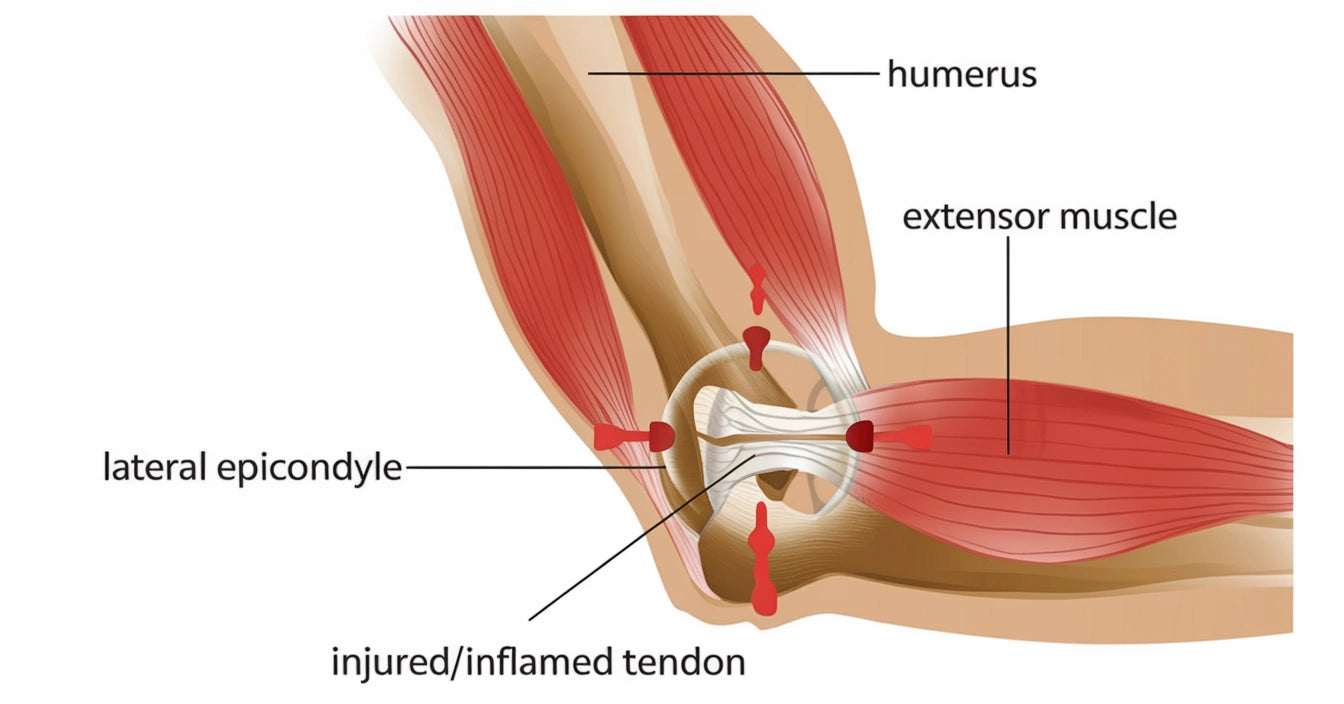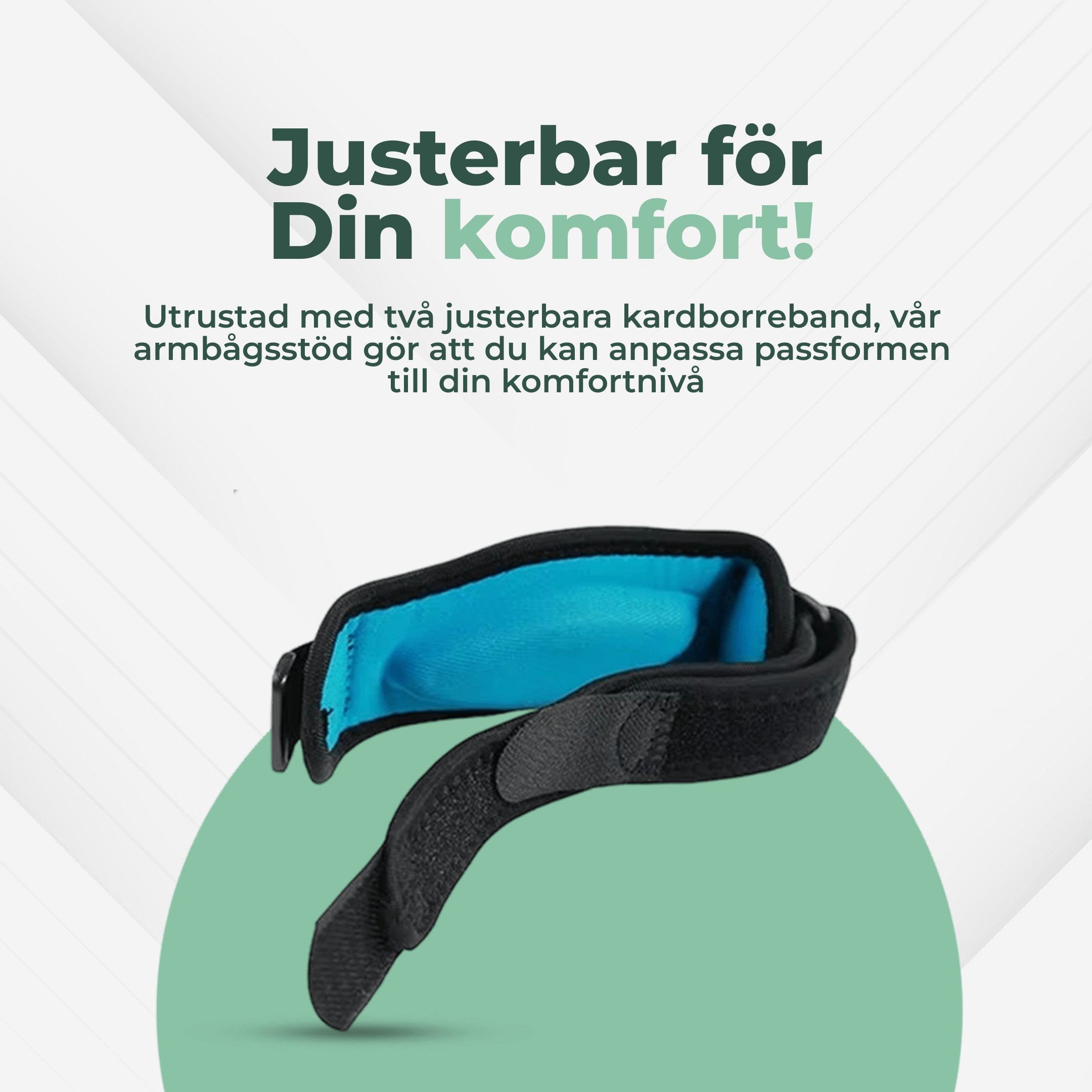Tennisalbue: Symptomer, årsaker og behandling

Tennis elbow, also known as lateral epicondylitis or elbow tendinitis, is a painful condition that affects the outside of the elbow. Despite its name, it is not limited to tennis players. In this article, we will review the most common symptoms, causes, and treatment options for tennis elbow.
What is tennis elbow? An introduction to lateral epicondylitis
Tennis elbow, also known as lateral epicondylitis, is an overuse injury to the outside of the elbow. It causes pain, stiffness, and weakness in the arm. Rest, physical therapy, and ergonomic aids can help relieve symptoms.
The condition occurs when there are small tears in the connective tissue that attaches the muscles to the outside of the elbow. The problem often comes on gradually after repeated strain, where the muscle attachment at the elbow is overloaded. A "false tennis elbow" can sometimes occur when the pain actually comes from a neck problem , but the symptoms are similar to classic tennis elbow.
Symptoms of tennis elbow: Common signs and symptoms
Tennis elbow often develops gradually and can vary in severity. Common symptoms include:
- Pain on the outside of the elbow: This is often the most prominent symptom. The pain can radiate down the forearm and sometimes up the upper arm.
- Weakness in the hand and wrist: You may experience difficulty gripping or lifting objects, especially when your wrist is extended.
- Elbow stiffness: The joint may feel stiff, especially in the morning or after inactivity.
- Increased pain with certain activities: Pain often worsens with activities that involve twisting the forearm or bending the wrist backward.
- Tenderness to the touch: The area around the outside of the elbow may be tender to pressure.
Elbow pain can be particularly noticeable during everyday activities such as lifting a milk carton or using a screwdriver. Many people describe it as painful to reach out and grab things. Long-term problems can lead to continuous pain even at rest, and can affect the ability to perform normal daily activities.
Causes of tennis elbow: Overuse, tennis, and repetitive movements
Several factors can contribute to the development of tennis elbow:
- Overuse: Repetitive movements involving the wrist and forearm are the most common cause.
- Occupation or hobby: People who work with computers, musicians, painters, and others who perform repetitive hand movements are at higher risk.
- Incorrect technique: When playing sports or working, incorrect technique can increase the strain on the tendons.
- Age: The condition is most common among people over 40 years of age.
- Weak muscles: Weakness in the forearm muscles can increase the risk of overuse injuries.
Despite the name, most people with tennis elbow do not suffer from playing tennis. Unilateral movements at work or in everyday life are more common causes. Ruptures in the muscle attachments can occur gradually through repeated strain, or suddenly with a single overexertion. Poor ergonomics when working at a computer can also increase the risk of muscle attachment injuries in the elbow.
Diagnosis, exercises and treatment of tennis elbow
Tennis elbow (lateral epicondylitis) is caused by repetitive strain on the muscles and tendons of the forearm. The condition causes pain around the outside of the elbow, especially when gripping, lifting, or twisting. Early diagnosis and proper treatment are essential to reduce pain and restore normal function.
Rest and relief
The first step is to reduce the strain on the elbow to avoid exacerbating the inflammation.
Tennis elbow protection provides stability and reminds you to avoid overexerting movements.
Physiotherapy
Purposeful exercises help strengthen muscles and tendons and improve blood circulation.
Tennis elbow pads support the joint during training and rehabilitation, promoting healing.
Anti-inflammatory drugs
If needed, over-the-counter anti-inflammatory medications can reduce pain and swelling.
Regular use of Tennis Elbow Protector can reduce the need for medication through natural support.
Ergonomic adjustments
For people with repetitive movements in work or sports, ergonomic improvements can make a big difference.
Tennis elbow pads complement ergonomic adjustments by relieving pressure on the elbow during everyday activities.
Important to consider
A structured exercise program with tennis elbow exercises is often an important part of treatment. A physiotherapist can create an individualized plan to gradually strengthen the muscles and improve blood circulation in the area. In some cases, pain relief from a pharmacy may be necessary during the acute phase, but in the long term, exercise and rest are the most effective measures.

Tennis elbow protection: How the right protection reduces stress on the wrist
The tennis elbow protector from Komforten offers several benefits for people suffering from tennis elbow:
- Provides targeted pressure on the muscles below the elbow, which relieves the attachment of the tendons.
- Helps distribute the load over a larger surface area, reducing stress on the injured area.
- Can be used during daily activities to provide continuous support and remind you to avoid overexertion.
- Supports rehabilitation exercises and can contribute to faster recovery.
- Prevents further injury by limiting extreme movements that can aggravate the condition.
A tennis elbow brace works best when used regularly during activities that put stress on the arm. The brace creates even pressure that relieves the inflamed muscle attachment and supports the injury during the healing process. For many, it can be an important part of treatment to be able to continue with necessary daily activities while healing continues.
Buy nowConclusion
Tennis elbow can be a painful and frustrating condition, but with proper diagnosis and treatment, most people can experience significant improvement. By combining rest, physical therapy, and the use of supportive devices like the Tennis Elbow Protector from Komforten, many people can effectively manage their symptoms and return to normal activities. It is important to be patient during the healing process and to work proactively to reduce the risk of recurrence.
Things you can do yourself to speed up healing include being mindful of your posture, using ergonomic tools, taking regular breaks from work, performing recommended exercises, and being careful not to overuse your arm during the healing phase. With the right combination of self-care, professional treatment, and supportive devices, most cases of tennis elbow can heal without lasting damage.
Frequently Asked Questions (FAQ)
How long does it take to recover from tennis elbow?
Recovery time varies, but with the right treatment, many people can see improvement within 6-12 weeks. More severe cases may take longer.
Can I continue to exercise with tennis elbow?
Light exercise and specific rehabilitation exercises can often be beneficial, but it is important to avoid activities that aggravate the pain. Consult a physical therapist for a customized program.
How do I use the Tennis Elbow Protector for the best effect?
Use the brace as directed, usually during activities that put stress on the elbow. It should fit comfortably but not too tight.
Can tennis elbow be prevented?
Yes, by using the right technique during sports and work, taking regular breaks, stretching and strengthening the forearm muscles, the risk of tennis elbow can be reduced. Using the Tennis Elbow Protector can also be preventive during risky activities.
What is the difference between tennis elbow and golfer's elbow?
Tennis elbow affects the outside of the elbow, while golfer's elbow affects the inside. Both conditions are caused by overuse but involve different muscles and tendons.

